Radiant Cut Diamond Buying Guide
Understanding the quality, diamond grades and cost of radiant diamonds
Understanding the quality, diamond grades and cost of radiant diamonds
The radiant cut diamond is a dazzling choice, known for its brilliant sparkle compared to other square/rectangular cuts. Its unique design not only provides a larger appearance compared to its actual carat weight but also ensures durability. When considering a radiant cut, it’s vital to focus on its quality and proportions to truly capture its radiant essence. Everything else being equal, a well-cut radiant can be almost as brilliant as a round diamond but cost significantly less.
A radiant cut diamond offers outstanding brilliance and durability. For color, we recommend an H or better, and for clarity, we suggest an SI1 or an SI2. When it comes to cut quality and other diamond details, this article will answer all your radiant cut questions. If you follow our guidelines a one carat radiant cut will cost $2,900.
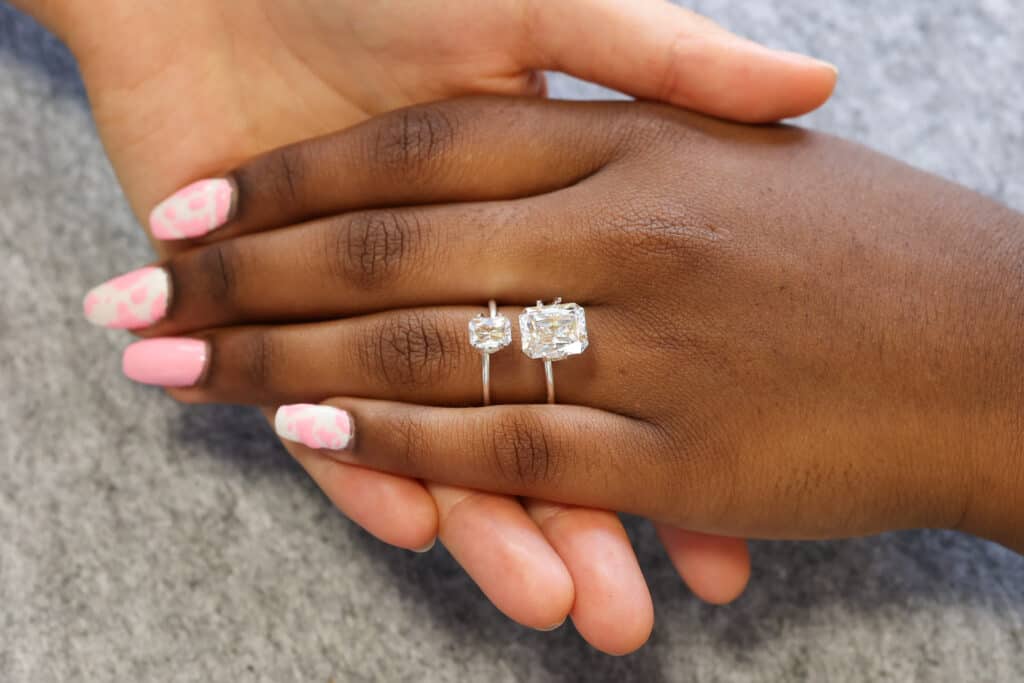
What is a radiant cut diamond?
What are the pros and cons of radiant cut diamonds?
What cut quality to focus on with a radiant cut diamond?
What is the best length to width ratio for a radiant cut diamond?
What clarity to choose for a radiant diamond?
Which diamond color is the most suitable for a radiant cut?
Should I buy a certified radiant cut diamond?
Do radiant cut diamonds look bigger?
What is the difference between a radiant cut vs. cushion cut?
What is the difference between a radiant cut and a princess cut?
Why you should trust us
Popular since the 1980s, the radiant cut diamond lives up to its name: it is impressively radiant and brilliant. Henry Grossbard designed the radiant cut in 1977 in pursuit of combining the finest elements of the round brilliant cut and the emerald cut.
The radiant cut diamond owes its brilliance to the 70 facets found in its pavilion and crown. The precision of each facet offers immense brilliance and fire. The radiant cut’s brilliance is surpassed only by the round brilliant cut.
This makes the radiant cut an excellent choice for an engagement ring that sparkles with brilliance and fire.
With carefully beveled corners, Radiants have substantial durability against chips and breakage, making it an excellent choice for those with an active lifestyle. This feature also allows the Radiant to be paired alongside both square and rounded diamonds, like in this 1.0 carat radiant in a 14K white gold channel setting from James Allen.
Like other diamond shapes, radiant cut diamonds have their own unique range of advantages and disadvantages. It is a unique cut that puts a little flair on your traditional ring. Even some celebrities have chosen to go the radiant cut route, such as Christina Haack’s stunner as reported by Hollywood Life.
Pros of the radiant cut include the following:
Although the radiant cut isn’t quite as brilliant as the round brilliant cut, it’s not very far behind. Because of the 70 facets in its pavilion and crown, the radiant cut offers impressive brilliance and fire. This makes the radiant cut a great choice if you want a non-round diamond with a beautiful sparkle.
The radiant cut is well known for looking larger than most of the other diamonds of the same carat weight, giving it some extra presence on your fiancé-to-be’s finger.
The face-up area of the radiant cut is actually slightly smaller than that of a round brilliant cut diamond of an equal carat weight. However, the radiant cut’s long diagonal measurement tricks the eye and makes it look larger than it really is.

The radiant cut is often compared to square diamonds, such as the princess cut. Although it looks quite different (the princess cut is square, while the radiant cut is square or elongated), it’s easy to see the similarities.
However, the radiant cut has one advantage over the princess cut — it’s far more durable. Because the radiant cut has beveled corners, radiant cut engagement rings are less likely to chip, making the shape a good option if your fiancé-to-be has an active lifestyle.
The cutting process for the radiant diamond uses a large percentage of the original rough diamond, with very little going to waste. This means that a loose radiant diamond will be priced lower on a per-carat basis than most other diamond cuts. In fact, the radiant cut diamond is one of the most affordable diamond shapes.
For example, this 1.01 carat, VS1 clarity, H color radiant cut diamond from James Allen costs $3,920. Meanwhile, this round brilliant cut diamond of the same clarity, color and carat weight costs $6,130 — almost 56% more. By choosing a radiant cut over a round brilliant, you’ll be able to spend more of your budget on the engagement ring setting, or on a larger diamond.
Unfortunately, like every other diamond shape, the radiant cut isn’t without its weak points. Cons of the radiant diamond cut include the following:
The cut of a diamond is absolutely vital to its appearance, determining its level of brilliance (how much light the diamond will reflect, allowing it to sparkle). Simply put, a poorly cut diamond won’t look anywhere near as beautiful once it’s set in an engagement ring as a well cut diamond.
For round brilliant cut diamonds, assessing cut quality is easy — just look at the GIA certificate. Unfortunately, the GIA doesn’t grade the cut quality of radiant cut diamonds, meaning this is something you’ll need to check yourself with a careful eye.
To make this easier, we’ve included cut quality guidelines for the radiant cut further down the page. If you’re not sure what to look for, or just prefer an expert’s opinion, feel free to contact us for help assessing a radiant cut diamond’s cut quality.

Radiant diamonds are created with a modified brilliant cut facet pattern for both the pavilion and crown, giving this diamond its high level of brilliance (the amount of white light reflected back to the eye or ‘sparkle’). Because diamond cut is vital to any diamond’s beauty, especially the radiant diamond, a careful eye must be used when considering stones for purchase.
The GIA only grades cut quality for round brilliant diamonds. A GIA certificate for a radiant cut will not include a cut grade and is therefore not indicative of how the diamond truly looks. If you’re comparing loose radiant diamonds, make sure they’re evaluated carefully by your eyes and, ideally, the eyes of a professional.
As a rough guideline, we offer suggestions for evaluating a Radiant Diamond’s Cut.
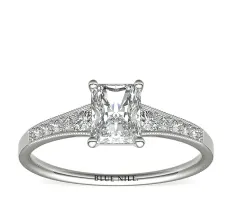
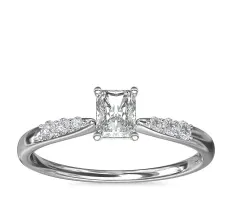
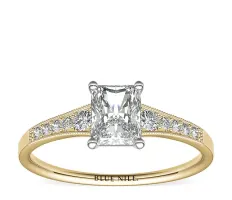
| Excellent | Very Good | Good | Fair | Poor | |
|---|---|---|---|---|---|
| Table % | 61-69 | 57-60 or 70-72 | 54-56 or 73-74 | 51-53 or 75-79 | <51 or >79 |
| Depth % | 61-67 | 59-58.9 or 70.1-74 | 54-56.9 or 74.1-79 | 54-56.9 or 74.1-79 | <54 or >79 |
| Girdle | Very Thin – Slightly Thick | Very Thin – Thick | Very Thin – Very Thick | Extremely Thin – Extremely Thick | |
| Cutlet | None | Very Small | Small | Medium | >Medium |
Be sure to also look at the corners of a radiant, ensuring they are even and not too wide—or too narrow. The cropped corners of the Radiant give it stability, but also need to be symmetrical in order to maintain the overall beauty.
For one-on-one guidance on choosing a high quality radiant cut diamond, contact our experts today.
| Excellent | Very Good | Good | Fair | Poor | |
|---|---|---|---|---|---|
| Square | 1.00–1.03 | 1.04-1.05 | 1.06-1.08 or >1.08 | >1.08 | |
| Rectangle | 1.20-1.30 | 1.15-1.19 or 1.31-1.35 | 1.10-1.14 or 1.36-1.40 | 1.08-1.09 or 1.41-1.50 | <1.08 or >1.50 |
A diamond’s length to width ratio signifies how proportionate the diamond is with its intended shape (i.e. square vs. rectangular) and is determined by dividing the diamond’s length by width. As an example, if a diamond’s length measures 5mm and its width is 3.5mm, the length to width ratio is 1.43.
The ratio you choose for your radiant diamond is entirely dependent on what you find to be the most aesthetically pleasing. A common range for radiant length to width ratios is 1.00-1.35, with the lower end indicating a more square shape. Length to width ratios can go up to 2.0 for a more rectangular shape.
For loose radiant diamonds, you can check the length to width ratio on the loose diamond page. Blue Nile display this in the “Diamond Details” section, below the photos of the diamond, while James Allen display it in the “Product Details” section.
You’ll notice the diamonds in this illustration vary in their ratios. From the lower end, 1.15, the Diamond is close to a square shape, while the higher end of 1.35 boasts a more vivid rectangular shape. Review several different length to width ratios before deciding on what you prefer.
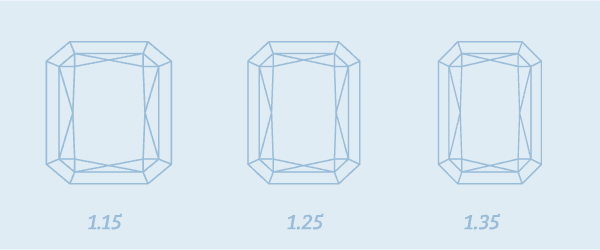
Diamond clarity describes how clean a diamond is. In other words, it measures of how free of inclusions and blemishes it is.
The GIA ranks clarity on the following scale:
The difference in appearance between two adjacent grades, such as VVS1 and VVS2, is rarely distinguishable to the naked eye.
In addition, radiants are cut with many facets and angles, making them look like crushed ice. This radiant cut in a 14K white gold solitaire setting from James Allen demonstrates the unique cracked ice appearance. Because of this feature, inclusions and flaws are more easily hidden. For this reason, we generally recommend radiant cut diamonds in a clarity of either S1 or S2, to ensure you’re not paying for a feature that won’t be noticed.
More than anything, we recommend carefully reviewing a radiant cut diamond for inclusions and blemishes, and having an expert assist you.
In addition to cut and clarity, you’ll want to review radiant cuts for their color. As graded by the GIA, color rankings range from D to Z. The D grade represents the best diamond color, colorless diamonds while the Z grade represents those with noticeable yellow or brown tint.

The differences in color for radiant cuts are slightly easier to perceive than other diamond shapes. Still, we generally recommend an H color or better for radiant cut diamonds, allowing your budget to be spent on other aspects, like cut quality. To the naked eye, an H grade will appear white and colorless to the naked eye.
You’ll also want to make sure your diamond appears white in relation to its setting. For example, even this J Color Radiant Cut Diamond from James Allen looks colorless in a 14K yellow gold solitaire setting. Depending on the setting you choose, you have flexibility with your Color range—ensuring you spend in the most important area: Cut quality.
While many lab grading entities issue reports for radiant cut diamonds, only a couple entities are trustworthy. Based on our many years of experience, we’ve found the GIA diamonds graded consistently and accurately, while other labs are dangerously inconsistent.
We strongly suggest only considering Radiants that have certificates issued by GIA. Diamond sellers that consistently offer these certificates include James Allen and Blue Nile.
In addition to receiving a lab report, you’ll want to review any diamond thoroughly before making a decision. Lab reports do not indicate how the diamond will appear. True beauty and appearance can only be assessed by you and an expert.
Shop for radiant cut diamond enegagement rings here.
Because Radiant Cuts have such potential for brilliance, we suggest having an experienced diamond professional assist you to ensure maximum sparkle at an excellent price.
As we mentioned above in the pros and cons of the radiant cut, radiant cut diamonds tend to look bigger than most of the other diamond shapes of the same carat weight.
This isn’t an accident. When Henry Grossbard designed the radiant cut in the 1970s, he did so aiming to create a diamond cut that looked as large as possible. His aim was to maximize the natural beauty of each diamond, rather than to cut it to maximize weight, as was the typical approach at the time.
Because of the radiant cut’s broad, shallow design, more of the diamond is visible when it’s set in a ring, helping to create the appearance of a larger stone. The end result is a shape that combines the best of the brilliant cut — namely, its brilliance — with a larger perceived size.
Are you not sure what size to choose? Maybe this simple graphic will help you:
While radiant and cushion cut diamonds contain similarities, they have distinct differences when it comes to Cut and appearance. Both showcase trimmed corners for increased stability, though Cushion Cuts have more rounded edges while Radiants carry distinct edges.
The numerous facets and large table of the Radiant provide exceptional, hard-to-beat brilliance. The Cushion Cut also offers brilliance, but is better known for its immense fire (colored light reflections).
Though length to width ratios are dependent on personal preference, Radiant and Cushion Cuts are available in an array of square to rectangular compositions. More often than not, Cushion Cuts are purchased with a length to width ratio of 1.0-1.09, which is indicative of a more squared shape than Radiants.
Cushion and Radiant Cuts are distinct shapes and choosing one over another is purely based on personal preference. To make the best decision, consider the loved one receiving the stone and their personal style. If you’re still unsure which to choose, contact our experts for more advice and direction.
You can also peruse recently purchased rings from our highest rated retailers to see what you like or go to our radiant vs. cushion cut comparison article here.
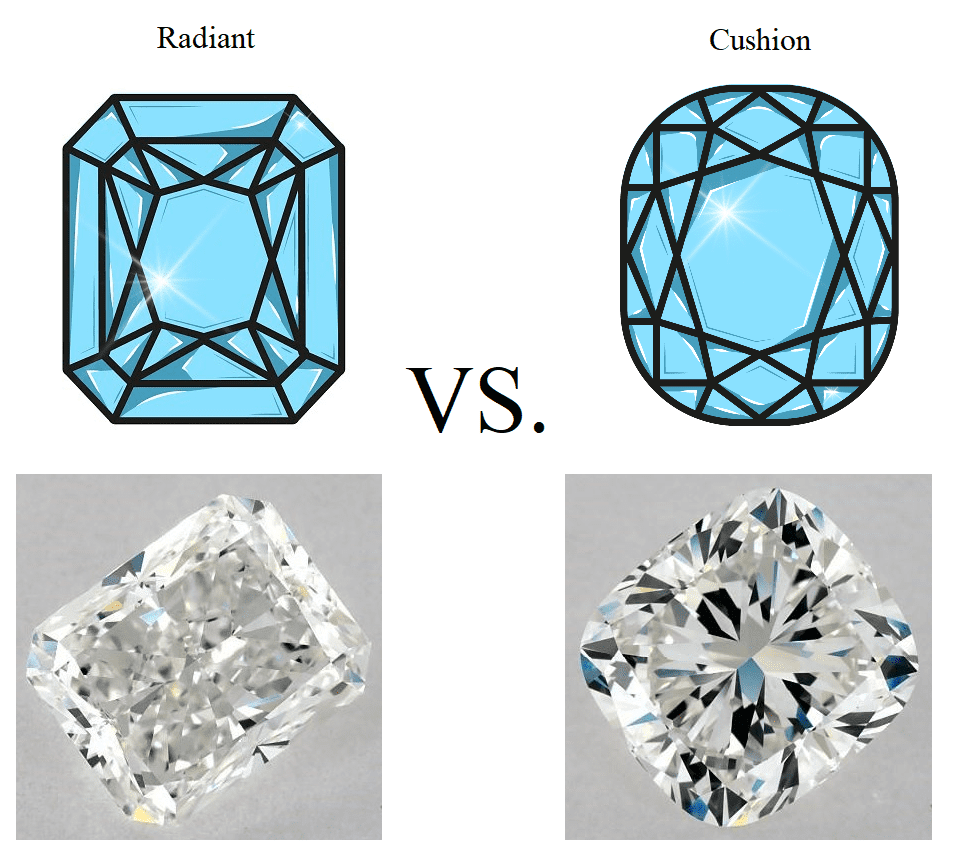
In addition to sharing some characteristics with the cushion cut, the radiant cut also shares several common features with the princess cut. In fact, at first glance, it can easily look like a halfway point between the cushion cut and the princess cut.
With this said, there are several key differences between the radiant cut and the princess cut.
First, the radiant cut has beveled corners, while the princess cut has sharp, uncut corners. This gives the princess much more of a square, sharp look to its edges.
Second, the radiant cut is typically elongated, whereas the princess cut is a square shape. While square radiant cut diamonds do exist, they’re not very common and make up only a small percentage of all radiant cut diamonds sold.
Can’t decide between a radiant or princess cut diamond? We’ve compared the two shapes in more detail here, covering their pros and cons, unique features and value for money.

For a diamond that bursts with brilliance and sparkles from across the room, consider a radiant cut diamond. Ensure you closely review each diamond for its cut quality, clarity and color, along with its overall beauty and appeal.
Contact our experts to ensure your radiant cut diamond lives up to its name—and price.




Before you buy a diamond, get personal buying advice from industry veterans. We'll help you get the best diamond for the money.
DISCLAIMER: We don't use your email for marketing. Period.
A diamonds’ price is determined primarily by the 4 Cs of the diamond. On the wholesale level, diamond prices are first based on a diamond shape and
When purchasing a diamond engagement ring, it’s important to find the right retailer to purchase it from. Some retailers excel at niche products li
A wide range of 1 carat diamonds exist both in online markets and local diamond jewelry stores. Not only are there significant differences in beauty
Please enter your email address to receive your 25% off coupon code:
Here is your coupon code: GFDSF3GF